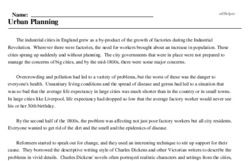Urban Planning
The industrial cities in England grew as a by-product of the growth of factories during the Industrial Revolution. Wherever there were factories, the need for workers brought about an increase in population. These cities sprang up suddenly and without planning. The city governments that were in place were not prepared to manage the concerns of big cities, and by the mid-1800s, there were some major concerns.
Overcrowding and pollution had led to a variety of problems, but the worst of these was the danger to everyone's health. Unsanitary living conditions and the spread of disease and germs had led to a situation that was so bad that the average life expectancy in large cities was much shorter than in the country or in small towns. In large cities like Liverpool, life expectancy had dropped so low that the average factory worker would never see his or her 30th birthday.
By the second half of the 1800s, the problem was affecting not just poor factory workers but all city residents. Everyone wanted to get rid of the dirt and the smell and the epidemics of disease.
Reformers started to speak out for change, and they used an interesting technique to stir up support for their cause. They borrowed the descriptive writing style of Charles Dickens and other Victorian writers to describe the problems in vivid details. Charles Dickens' novels often portrayed realistic characters and settings from the cities, and Dickens himself was consulted for a report on sanitary conditions in British towns.
Other conditions helped to make the time right for change. For instance, more people were now able to vote. Also, wages were rising and food was becoming cheaper. People with a bit more money and the vote were more likely to become involved in working for changes.




